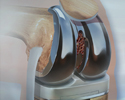Taking care of your new knee joint
Knee arthroplasty - precautions; Knee replacement - precautionsWhat to Expect at Home
After you have knee replacement surgery, you will need to be careful about how you move your knee, especially for the first few months after surgery.
After you have knee replacement surgery
You will stay in the hospital for 1 to 3 days after having hip or knee joint replacement surgery. During that time, you will recover from your anest...
Read Article Now Book Mark ArticleIn time, you should be able to return to your previous level of activity. But even then, you will need to move carefully so that you do not injure your new knee replacement. Be sure to get your home ready for when you return, so you can move more easily and prevent falls.
Prevent falls
Older adults and people with medical problems are at risk of falling or tripping. This can result in broken bones or more serious injuries. Use the ...
Read Article Now Book Mark ArticleGetting Dressed
When you are getting dressed:
- Avoid putting your pants on while standing up. Sit on a chair or the edge of your bed, so you are more stable.
- Use devices that help you get dressed without bending too much, such as a reacher, a long-handled shoehorn, elastic shoe laces, and an aid for putting on socks.
- First put pants, socks, or pantyhose on the leg that you had surgery on.
- When you undress, remove clothes from your surgery side last.
Sitting
When you are sitting:
- Try not to sit in the same position for more than 45 to 60 minutes at a time.
- Keep your feet and knees pointed straight ahead, not turned in or out. Your knees should be either stretched out or bent in the way your therapist instructed.
- Sit in a firm chair with a straight back and armrests. After your surgery, avoid stools, sofas, soft chairs, rocking chairs, and chairs that are too low. Sitting on a cushion can help you from sitting too low. It can be difficult to get up from a low chair after knee surgery.
- When getting up from a chair, slide toward the edge of the chair, and use the arms of the chair, your walker, or crutches for support to get up.
Bathing and Showering
When you are bathing or showering:
- You may stand in the shower if you like. You can also use a special tub seat or a stable plastic chair for sitting in the shower.
Special tub seat or a stable plastic ch...
Older adults and people with medical problems are at risk of falling or tripping. This can result in broken bones or more serious injuries. The bat...
Read Article Now Book Mark Article - Use a rubber mat on the tub or shower floor. Be sure to keep the bathroom floor dry and clean.
- Do not bend, squat, or reach for anything while you are showering. You can use a reacher if you need to get something.
- Use a shower sponge with a long handle for washing.
- Have someone change the shower controls for you if they are hard to reach.
- Have someone wash the parts of your body that are hard for you to reach.
- Do not sit down in the bottom of a regular bathtub. It will be too hard to get up safely.
- If you need one, use an elevated toilet seat to keep your knees lower than your hips when you use the toilet.
Using Stairs
When you are using the stairs:
- When you are going up stairs, step first with your leg that did not have surgery.
- When you are going down stairs, step first with your leg that did have surgery.
- You may need to go up and down one step at a time until your muscles get stronger.
- Make sure you hold onto the banister or holders along the stairs for support.
- Check to make sure that your banisters are in good condition prior to surgery. It is important to make sure it is safe to use them.
- Avoid long flights of stairs for the first 2 months after surgery.
Lying Down
When you are lying down:
- Lie flat on your back. This is a good time to do your knee exercises.
- Do not place a pad or pillow behind your knee when lying down. It is important to keep your knee straight when resting.
- If you need to raise or elevate your leg, keep your knee straight.
Getting Into and Riding in a car
When getting into a car:
- Get into the car from street level, not from a curb or doorstep. Have the front seat moved back as far as possible.
- Car seats shouldn't be too low. Sit on a pillow if you need to. Before you get into a car, make sure you can slide easily on the seat material.
- Turn around so the back of your knee is touching the seat and sit down. As you turn, have someone help lift your legs into the car.
When riding in a car:
- Break up long car rides. Stop, get out, and walk around every 45 to 60 minutes.
- Do some of the simple exercises, like ankle pumps, while riding in the car. This helps reduce the risks of blood clots.
- Take pain medicines before your first ride home.
When getting out of the car:
- Turn your body as someone helps you lift your legs out of the car.
- Scoot and lean forward.
- Standing on both legs, use your crutches or walker to help you stand up.
Ask your surgeon when you can drive. You may need to wait up to 4 weeks after surgery. Do not drive until your surgeon says it is OK.
Walking
When you are walking:
- Use your crutches or walker until your health care provider or physical therapist tells you it is OK to stop, which is often around 4 to 6 weeks after surgery. Use a cane only when your provider tells you it is OK.
Crutches
It is important to start walking as soon as you can after your surgery. But you will need support for walking while your leg heals. Crutches may be...
Read Article Now Book Mark ArticleWalker
It is important to start walking soon after a leg injury or surgery. But you will need support while your leg is healing. A walker can give you sup...
Read Article Now Book Mark Article - Put only the amount of weight on your knee that your provider or physical therapist recommends. When standing, stretch your knees as straight as possible.
- Take small steps when you are turning. Try not to pivot on the leg that was operated on. Your toes should be pointing straight ahead.
- Wear shoes with nonskid soles. Go slowly when you are walking on wet surfaces or uneven ground. Do not wear flip-flops, as they can be slippery and cause you to fall.
Activities you Cannot do After Full Recovery
You shouldn't downhill ski or play contact sports such as football and soccer. In general, avoid sports that require jerking, twisting, pulling, or running. You should be able to do lower-impact activities, such as hiking, gardening, swimming, playing tennis, and golfing.
Other directions you will always need to follow include:
- Take small steps when you are turning. Try not to pivot on the leg that was operated on. Your toes should be pointing straight ahead.
- Do not jerk the leg that was operated on.
- Do not lift too much weight. This will place too much stress on your new knee. This includes grocery bags, laundry, garbage bags, tool boxes, and large pets.
References
Hui C, Thompson SR, Giffin JR. Knee arthritis. In: Miller MD, Thompson SR, eds. DeLee, Drez, & Miller's Orthopaedic Sports Medicine. 5th ed. Philadelphia, PA: Elsevier; 2020:chap 104.
Mihalko WM. Arthroplasty of the knee. In: Azar FM, Beaty JH, eds. Campbell's Operative Orthopaedics. 14th ed. Philadelphia, PA: Elsevier; 2021:chap 7.
-
Osteoarthritis
(Alt. Medicine)
-
Osteoarthritis - InDepth
(In-Depth)
-
Glucosamine
(Alt. Medicine)
-
Chondroitin
(Alt. Medicine)
-
Rheumatoid arthritis - InDepth
(In-Depth)
-
Gout - InDepth
(In-Depth)
-
Low back pain
(Alt. Medicine)
-
Gout
(Alt. Medicine)
-
Lyme disease and related tick-borne infections - InDepth
(In-Depth)
-
Cat's claw
(Alt. Medicine)
Review Date: 8/12/2023
Reviewed By: C. Benjamin Ma, MD, Professor, Chief, Sports Medicine and Shoulder Service, UCSF Department of Orthopaedic Surgery, San Francisco, CA. Also reviewed by David C. Dugdale, MD, Medical Director, Brenda Conaway, Editorial Director, and the A.D.A.M. Editorial team.



